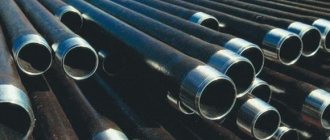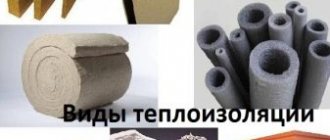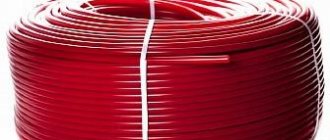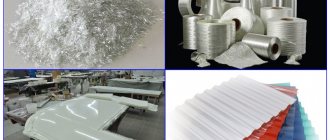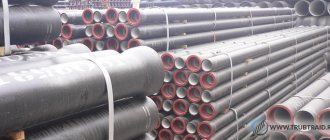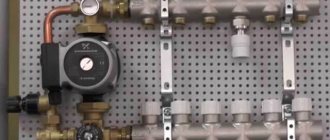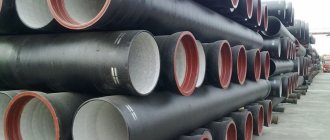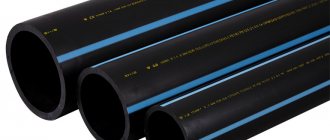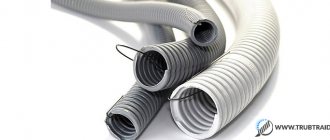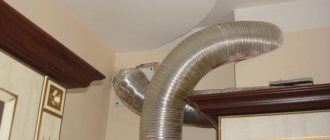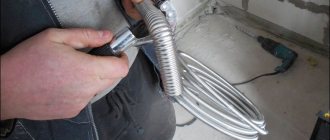Corrugated pipe for heated floors has been an excellent assistant in home design for many years.
Where this material came from, how exactly and why it is used in the repair and improvement of a private home, as well as the pros and cons of corrugated pipes: we will try to find out all this in this article. The progenitor of modern corrugated pipes for heated floors appeared at the end of the 20th century in the scientific center of the world, Japan. Scientists were looking for the most durable and earthquake-resistant option for laying various types of communications.
General information
This invention became a real scientific breakthrough of that time, as it combined two seemingly incompatible qualities: strength and flexibility. A few years later, it was appreciated and began to be studied in detail in South Korea and European countries, and only relatively recently mass production began in Russia. The main competitive advantage was the wide scope of application of the invention. The first to evaluate the characteristics of such an important innovation, as expected from the beginning, were builders.
The first corrugated pipes were used for laying various types of communications, which we can observe to this day. The physical characteristics of corrugated material allow it to be used even in the most extreme conditions. The flexibility and strength of the material used in the manufacture of pipes provides a wide range of applications for this invention.
Strict adherence to manufacturing technology is the key to high quality performance of corrugated pipes.
The production process includes several fairly simple steps:
1) The pipe is formed from a specialized steel strip;
2)
In the process of making workpieces, tungsten electrodes are used;
3) The workpiece is cooked at very high temperatures up to 1150 °C;
4) The reliability of connections is checked using a laser system;
5) Pipe corrugation occurs on special oxen of different diameters;
6) Heat treatment is performed under different temperature conditions;
7) Packaging and packing of finished products;
Check for defects and various damages.
Grade
Fastening polypropylene pipes to the wall.
Types and methods of fastening, installation tips Dry numbers speak for themselves: we have before us an exceptionally durable and almost eternal material for water supply distribution. However, we will try to give it as unbiased an assessment as possible, weighing all the advantages and disadvantages of the solution.
pros
- Thanks to corrugation, the pipe is not afraid of water hammer. The high annular rigidity of the walls allows them to withstand high pressure, and their plasticity makes it possible to slightly change the length (and, accordingly, the internal volume) of the water supply pipe during a short-term pressure surge, acting as a damper;
- For the same reason, corrugated stainless steel tolerates freezing and thawing. Ice expanding during crystallization will not tear it, but will only cause it to slightly lengthen;
- The pipe bends easily, and the permissible bending radius is equal to its diameter. This feature means that the water supply parts do not need to be precisely adjusted to size, and also allows you to do without fittings at the bends of the water supply system;
The flexible pipe does not need corners: it bends at any angle with a minimum radius
Stainless steel is sold in coils of 50 meters or more in length, which makes it an ideal material for laying in screeds or grooves;
Roller pipe cutters for stainless steel
Neither pipes nor fittings are afraid of deviations from the standard temperature for hot water supply. The theoretical maximum water temperature in the heating main - +150 degrees - fits into the declared characteristics.
Minuses
Alas, it could not have happened without them.
Despite the low material consumption, a stainless steel pipe is noticeably more expensive than a polypropylene or metal-plastic pipe. In wholesale quantities, a linear meter of pipe with a diameter of 15 mm costs 105 rubles or more. For comparison, a meter of polypropylene pipe without reinforcement with the same throughput (diameter 20 mm) can be bought for... 20 rubles;
Inexpensive domestically produced pipes are sold under the Neptune brand
The material and corrugated surface of the walls provide the highest thermal conductivity. For underfloor heating systems this is an advantage, but for plumbing it’s the opposite: hot water will quickly cool down, and cold water will heat up;
The polyethylene shell greatly reduces the thermal conductivity of the walls
- The flexibility of the pipe can play a bad joke on you: the water supply can be easily deformed simply by accidentally touching it;
- Finally, a serious disadvantage of corrugated stainless steel is the high hydraulic resistance of the water supply system. With its large length, the pressure loss can be calculated in tens of meters.
The video in this article will help you learn more about this material.
Peculiarities
The most significant drawback for many is the cost of corrugated pipes; not every builder can afford to buy them. However, if you take into account all the advantages, and especially durability and consumption, you can easily understand that the cost pays off many times over.
The second inconvenience when using corrugated pipes for installing heated floors is their vulnerability to electrochemical corrosion, which can be easily solved using grounding. Protection against walking currents must be installed on the collector to which the heated floor pipes are connected.
The installation of a water heated floor also has a number of features that need to be taken into account. At the design stage, it is necessary to understand the layout diagram, especially for large rooms, since corrugated pipe is sold in coils with a maximum length of 50 meters. For this reason, for large areas, installation in several independent circuits is recommended.
The outer diameter of the corrugated stainless pipe is from 20 mm, which in turn must be taken into account when designing the screed and the room as a whole. The inner diameter is usually 0.5 inches.
Installation of floors begins with pouring the so-called “draft”, the first layer of screed, followed by insulation and reinforcing mesh (optional). The pipe laying itself starts from the distribution manifold; accordingly, if the manifold is already installed, which is a more convenient way, then first of all we connect the pipe to the manifold.
Connections are made using brass fittings. If the collector is not available at this stage, then it is necessary to leave a supply of corrugated pipe for further installation. If there are several snowstorms, it is necessary to ensure that when connecting the pipes of different loops to the collector, they do not overlap each other.
After connecting to the collector or measuring the reserve, circuit loops are outlined. Due to the excellent thermal conductivity and the minimum thickness of the pipe walls, about 0.3 mm, the row spacing can be increased to 20-30 cm, where the recommended distance from the walls is 20 cm, and the distance between loops or rows is 30 cm.
Fastening of corrugated pipes is carried out according to the same scheme as when using metal-plastic or polyethylene pipes: either with clamps to the reinforcing mesh, if any, or with metal fastening tapes, brackets, mounting strips. With only one difference, if you do not have a reinforcing mesh, you can first install clips/staples at a row spacing, and then lay the corrugated pipe in the ready-made staples, rolling it out of the coil and giving it the required shape. In this case, it is necessary to be careful not to twist the pipe, which in the future can lead to kinks and, as a result, failure.
The pipe is cut using a standard pipe cutter, which will not cause any additional problems during installation. If you don’t have a pipe cutter, improvised methods and tools, such as a hacksaw, will do.
As we can see from all of the above, the installation of this type of corrugated pipes as a heated floor is a fairly simple process that, if desired and has time, can be handled alone, without special skills.
The procedure for installing a warm water floor from a corrugated stainless pipe
The procedure for installing a water floor heating system made of corrugated steel thin-walled pipe is no different from the standard one. The work is performed in the following sequence:
- You need to measure the area of the room. Calculate the required number of pipes, circuits, and pump power. Draw up a pipeline laying diagram.
- Inspect the base of the floor. If necessary, eliminate defects and differences in height. If the floor slope is more than 2 mm per 1 meter of room length, then it is necessary to perform a rough screed.
- After preparing the base, lay a layer of thermal insulation on the floor. This is necessary to direct the heat upward, into the room, and not onto the ceiling. It is preferable to use heat-insulating materials with a reflective layer (for example, foil).
- If the selected insulation itself does not have waterproofing properties, then it must be covered with film or other suitable material.
- Place reinforcing mesh. If special mats for heated floors with a corrugated surface are used as insulation, then the mesh is not needed. It is possible not to use reinforcement when laying it on rolled thermal insulation with a smooth surface, but then additional fastenings of the pipeline to the floor will be required.
- Lay the pipe according to the chosen pattern and fix it (attach it to the mesh or insulation; there is no need to additionally attach the pipeline to mats with “bosses”).
- Install the manifold, connect the pipes.
- For greater strength of the screed, you can lay another layer of reinforcing mesh on top of the pipeline.
- Before pouring the screed, it is necessary to check the functionality of the system. To do this, you need to fill it with water and heat the coolant to operating temperature. This should be done gradually, starting at 20 degrees C. After a few hours, increase the temperature by 5 degrees C. At this time, you need to monitor the pipes and their joints. If leaks are detected, they must be repaired immediately and then the pipeline must be refilled. Having brought the temperature to operating temperature, the system is left for 48-72 hours. If everything is in order, then the water heating is turned off.
- Prepare a mixture for the screed - cement-sand or special for heated floors.
- Make a screed approximately 5 cm thick in the usual way. You can fill it after the water in the system has cooled completely after checking. You can use a self-leveling mixture. It is much easier to apply, the surface will be perfectly smooth.
- After the floor has dried (a regular 4 cm thick screed takes about a month to dry), you can put the system into operation. Just as during the test, the temperature in the pipeline must be increased gradually, starting from 20 degrees C and raising each knock by 5 degrees.
Collector with corrugated stainless steel
In case of a “dry” installation of a floor heating system (without screed), pipes are laid in two ways:
- For modules made of chipboard, OSB with grooves. Their width is 13, 18, 28 cm. The desired one is selected depending on the selected pitch between the turns of the pipeline. Special metal heat distribution plates, which also have grooves, are mounted in the modules. The plates are made of galvanized steel or aluminum. Their upper flat edges fit closely to the floor covering.
- On special mats for heated floors with a corrugated surface. Heat distribution plates are also laid on top of the mats.
- On slats made of well-dried wood. The installation principle is the same as when laying on chipboard and OSB modules.
A layer of sound and waterproofing substrate is laid on top of the laid pipeline. You can install flooring on it. Under the tiles and carpet, you will additionally need to put a layer of plywood, chipboard or moisture-resistant plasterboard.
Results
The final and mandatory process in installing a heated floor is crimping. Thanks to this, the floor will serve you well for many years.
Currently, heated floors based on corrugated pipes are becoming more and more common, including in Russia. The leader in the production of corrugated stainless steel pipes is occupied by South Korean, which supplies corrugated pipes to many countries around the world. You may not be surprised if you hear that someone names their products after her. This is a fairly frequent and widespread phenomenon, proving their leading position in this market.
Sequence of work
Bored foundations with grillage technical characteristics and scope of application
First, cut off the required length of the corrugation. It is better to tighten the cable with a partner in a spacious room or outdoors. It is convenient to use a stand from which the cable can be removed without overlaps or loops.
- After unpacking, the corrugation is unwound and laid. One end of the cable is connected to a broach, which is located in the corrugation.
- They strip the cable, remove the insulation and leave one core, which is twisted into a loop. The loop is connected to the broach.
- A broach is pulled on one side, and the cable is unwound from the rack and tucked into the corrugation.
- Now that the cable is tightened, the corrugation needs to be rolled back into the coil; you will need a reel for winding the cable. Pack the cable using stretch tape. The cable is removed and twisted with tape. Now the bay is ready for transportation and installation.
- The metal sleeve is attached to the wall with an aluminum mounting strip, and the pipe should not sag.
- The corrugation is mounted under the plaster in grooves.
Installation of a "warm floor" system
To install the system, no special equipment is required; two adjustable wrenches are enough. The corrugation is fastened with fittings, the service life of the connecting elements is 50 years, the sealing rings are 30 years.
Warm floor system made of corrugated pipes.
The corrugated pipe structure increases heat transfer by 40% (2 m pipes with a diameter of 25 mm replace the area of one radiator section). If necessary, the same pipe can be used as a heated towel rail or radiator; the wiring can be completely made from it.
This is important to know
- It makes sense to install a heating system made of metal stainless steel in a country house; it can easily withstand sub-zero temperatures, and if it freezes, it can be treated with a hairdryer (construction or regular). Corrugation for a metal-plastic pipe cannot be heated in this way; it cannot withstand high temperatures and releases toxic substances when heated.
- Installation of corrugated communications is simple. First, the fitting is installed and the pipe is connected, and then the nut is tightened.
- If a flexible pipe is installed in a closed manner, concrete or soil takes on part of the load. Despite the fact that corrugated products have a high load-bearing capacity, the pipe can be deformed if there are voids between the corrugation and the wall.
- Such a pipe is fireproof, and this is especially important when laying hidden communications in wooden houses. In the event of a short circuit, the fire will not spread further.
The scope of application of metal corrugated products is wide; they are used in the construction of air conditioning and ventilation systems, heating and water supply. Large-diameter metal corrugated culverts have found their application in construction - these are tunnels, pedestrian underpasses, and water canals.
Add a comment
Types of corrugated pipes
Stainless
Corrugated products are used in gas and fire systems, when piping boilers and installing solar systems. Thanks to the special features of the pipe, their installation is quick and easy.
Stainless steel types of corrugation bend around obstacles due to their high ductility
Stainless steel corrugated pipe is plastic, microcracks do not form in places of bends, and the throughput does not change. During the work there is no need to use soldering and welding - installation of products is carried out using fittings. The maximum length of a solid pipe is 50 m. During installation, the corrugation should not be stretched too much.
Advantages
- The product can withstand pressure up to 50 atmospheres (working pressure 15 atmospheres).
- The pipe contains connecting elements.
- Operating temperature range -50°С..+110°С.
- The magnitude of longitudinal deformation is 2-3% of the total length.
- Easy to assemble, no corrosion, service life: 20 years.
Flaws
- The weak point is the longitudinal seam; under heavy loads there may be tears.
- High price compared to pipes made from other materials.
Aluminum
Such a pipe is not subject to corrosion and is quickly installed, but at the same time it has high thermal conductivity and low strength. The aluminum option is cheaper than the plastic one. This corrugated pipe is fire-resistant and inert to chemicals. Pipe elements are connected with couplings or sockets.
Plastic (HDPE)
The corrugated pipe is used for laying the cable, protects a person from electric shock, and the cable from damage and high humidity. A prerequisite for proper installation is the even laying of the channel on a smooth surface. Fastening is carried out with clips and staples. The flexible pipe can be laid at any angle.
Cheaper, lighter corrugations are used for interior work. More expensive, reinforced ones - for external ones. You should not save money by laying a lightweight version outdoors; the channel may be destroyed by frost and moisture.
Inside such pipes there is a probe for pulling the cable (sometimes corrugation is made without it). The diameter of such pipes ranges from 12 mm to 50 mm.
Installation of pipes in a screed, main stages and technology of work
Most often, craftsmen use the wet installation method to install heating pipes. It involves pouring pipes with a seamless floor.
Heating products are fixed to the reinforcing mesh. Be sure to check their tightness. A concrete screed is made on top.
Stage 1: level the surface
A man levels the surface
Before laying pipes, be sure to level the floor as much as possible. A difference of +/- 1 cm is allowed.
Otherwise, level the floor using another layer of concrete screed. Also, before starting installation work, it is worth removing as much dust or construction debris as possible from the floor surface and removing all communication points.
Stage 2: do waterproofing
Before laying pipes, care should be taken to ensure waterproofing. To do this, a thin (0.2 mm) plastic insulation film is laid on the floor.
Structural diagram of waterproofing
If the floor is located above a basement or garage (any cold) room, then you should also pre-lay insulating panels. Thus, heat will not be absorbed by the cold floor and will be distributed with maximum efficiency in the heated room.
Stage 3: laying pipes
For greater uniformity of heat distribution, heating pipes in the floor screed should be laid with the same distance between turns.
It is best to lay products in the form of a “snake” or “spiral”.
Example of “snake” and “snail” installation
The structure is secured with clips, paper clips or on a special mesh with grooves (one-sided locks) that securely fix the laid products.
Stage 4: fill the screed itself
The next step is to fill the laid heating pipes with a concrete screed.
When pouring concrete on the floor, it is worth foreseeing the presence of expansion joints in advance. They will protect the screed from possible deformation during the heating process. It is best to fill such expansion joints with polyurethane; the pipe in this place should be laid corrugated.
A concrete screed is a layer of poured concrete (from 30 to 70 mm), prepared from dry mixtures that contain fillers, various chemical additives, cement and sand.
This technology is used for optimal leveling of floor levels in both private and industrial settings.
The advantages of concrete screed are:
- Durability.
- Strength.
- Resistance to shrinkage (> 70MPa).
- Abrasion resistance (3).
After pouring the floor with concrete, you need to wait 3 to 4 weeks until the concrete layer dries. Then sand the surface with a grinding machine. This will make the concrete uniformly smooth and even. Next you can lay the flooring.
Read more: how to make a screed for a self-leveling floor (detailed technology is provided).
Types of flexible stainless steel pipes
In the last century, special attention was paid to the production of corrugated steel products. Their importance is difficult to overestimate: corrugations played a significant role in global structures, such as the Trans-Siberian Railway or the BAM
Stainless steel corrugated pipes can have completely different cross-sections - from 8 mm to 15 m. In addition to conventional water supply and gas flue corrugations, steel pipes with a non-standard cross-section are also produced:
- square (diameter 3-8 m) – used for constructing culverts and tunnels;
- arch pipes (2-13 m) – tunnels for travel under railways or road junctions;
- pear-shaped (1.5-8 m) – installation of a stainless steel culvert;
- vertical ellipse (1.5-6.5 m) – communication tunnels, culverts;
- arched (2-13 m) – pedestrian crossings, small bridges and road tunnels;
- horizontal ellipse (2.6-9 m) – water pipes;
- low profile arches (6-15 m) – railway and road tunnels.
Round corrugated pipes of large diameters (from 1.5 to 7 m) are used mainly in the construction of large-scale culvert structures. Smaller analogues will be used for private purposes, which will be discussed further.
Corrugation installation
The easiest way to install corrugated pipes is made of stainless steel. This is done in the following sequence.
- Cut the pipe using a pipe cutter and remove any burrs.
- Place the fitting and tighten the union nut.
- Secure the corrugation to the wall with fasteners. Check the system under pressure.
Wiring
A special electrical corrugated PVC pipe is used for installation of electrical wiring. The smaller the diameter of the product, the higher the flexibility of the plastic hose. The material is not flammable, a short circuit does not cause a fire. The products have dielectric properties, and inside them there is a probe for pulling the cable.
Open installation of corrugated cables
The pipe has a variable cross-section diameter: thin-walled spaces, which give flexibility, alternate with thick-walled ones, which create strength. The electrical corrugation has a steel wire inside, which allows you to tighten the harness into the pipe. The most common diameters are from 16 mm to 50 mm.
Installation is carried out as follows:
- The cable is insulated and connected to a broach located inside the corrugation.
- Then pull the wire through the corrugation. One person holds the broach, the other pulls the flexible pipe-hose onto the wire harness.
- Afterwards, the corrugated pipe is attached to the wall at equal distances (use an aluminum strip or plastic clips).
Sewerage
Double-layer corrugated pipes have a smooth inner surface and are therefore not prone to blockages. They are repairable and can withstand temperature changes. The internal cross-sectional diameter ranges from 200 mm to 850 mm, therefore such pipes are used when installing communications in a private house and in an industrial pipeline using the trenchless and open method.
In wastewater disposal systems, plastic corrugated pipes have an advantage over rigid pipes: they have less material consumption during installation.
Corrugated pipe is used for outdoor installation and for interior work, it bends easily in any direction, fits together with fittings and has a wide range of applications: it is used to connect a radiator to the heating system, install plumbing, ventilation and a fire safety system.
Heat transfer from stainless steel pipes is higher than from plastic pipes
Add a comment
